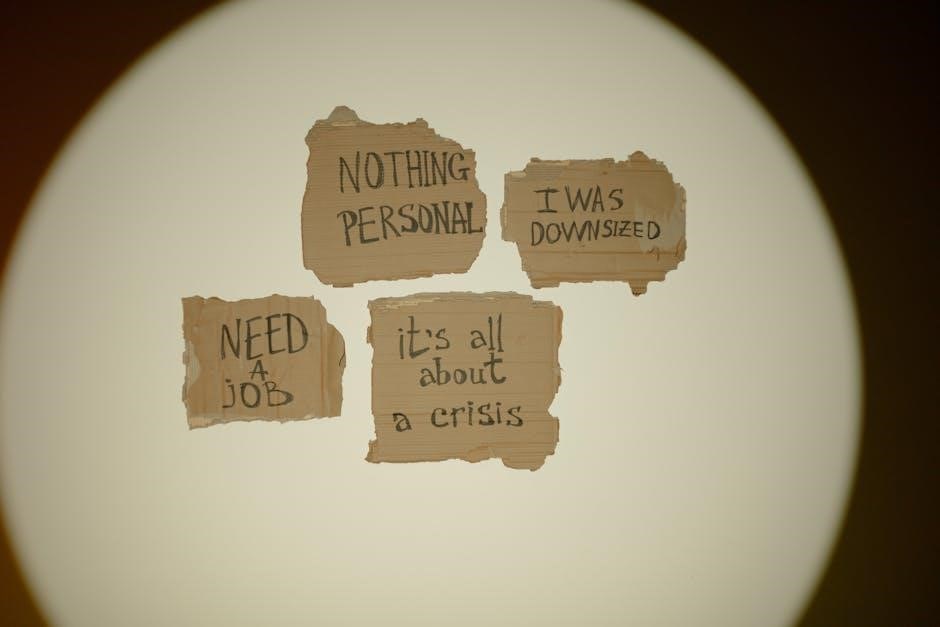Kazuo Ishiguro’s Never Let Me Go is a haunting novel exploring themes of humanity‚ love‚ and ethics through the eyes of clones. Its emotional depth and philosophical questions resonate deeply‚ making it a modern classic. The story‚ narrated by Kathy H.‚ delves into memories of Hailsham‚ uncovering the poignant truth about their existence. Available in PDF format‚ the novel remains a vital read for literary enthusiasts‚ sparking reflections on identity and morality.
1.1 Background of the Novel
Never Let Me Go‚ written by Kazuo Ishiguro‚ was published in 2005 and set in a dystopian England. The novel revolves around cloned beings created for organ donation‚ exploring themes of humanity‚ love‚ and ethics. The story unfolds through Kathy H.’s narration‚ reflecting on her past at Hailsham‚ a mysterious boarding school. Ishiguro’s unique style blends subtlety with profound philosophical questions‚ making the novel a critical and emotional masterpiece. Its exploration of identity and morality has captivated readers worldwide‚ solidifying its place in contemporary literature.
1.2 Genre and Style
Never Let Me Go blends elements of literary fiction‚ dystopian fiction‚ and speculative fiction‚ creating a unique narrative voice. Ishiguro’s prose is subtle‚ introspective‚ and emotionally nuanced‚ with a focus on memory and moral complexity. The novel’s style is characterized by its delicate balance of restraint and profound depth‚ allowing readers to reflect on the ethical dilemmas it presents. The use of a retrospective narrative‚ combined with an unreliable narrator‚ adds layers of mystery and invites readers to piece together the truth alongside Kathy H.

Plot Summary
Never Let Me Go follows Kathy H.‚ a clone raised at Hailsham‚ as she reflects on her life‚ friendships‚ and the revelation of her fate. The novel traces her journey with Ruth and Tommy‚ uncovering their shared past and the truth about their existence. A poignant exploration of love‚ loss‚ and identity‚ the story unfolds through Kathy’s memories‚ revealing the emotional depth of their struggles and the inevitability of their destiny.
2.1 Overview of the Story
Never Let Me Go is set in a dystopian England and follows Kathy H.‚ a clone raised at Hailsham‚ a mysterious boarding school. The story unfolds through Kathy’s reflections as she recounts her childhood‚ friendships with Ruth and Tommy‚ and the gradual revelation of her fate. The novel explores themes of identity‚ humanity‚ and the ethical implications of cloning‚ weaving a poignant narrative that blends love‚ loss‚ and existential inquiry. Kathy’s journey from innocence to acceptance underscores the emotional depth of her reality‚ leaving readers contemplating the value of life and societal norms.
2.2 Key Events and Turning Points
The novel’s pivotal moments include Kathy‚ Ruth‚ and Tommy’s childhood at Hailsham‚ where their bond forms and they uncover hints about their destiny. A turning point occurs when Miss Lucy reveals the truth about their existence‚ shattering their innocence. Tommy’s belief in a deferral through art becomes a central hope‚ while Kathy’s unrequited love for him adds emotional depth. Ruth’s deteriorating health and eventual donation mark a tragic shift‚ leading Kathy to confront her own fate and the reality of her world‚ culminating in a poignant acceptance of her role as a donor.

Major Themes
The novel explores themes of humanity‚ love‚ loss‚ and the ethical implications of cloning. These themes are central to the narrative‚ provoking deep reflection on identity and morality.
3.1 The Concept of Humanity
In Never Let Me Go‚ the concept of humanity is explored through the lives of clones‚ challenging societal norms about what defines human existence. The novel delves into themes of empathy‚ memory‚ and emotional connection‚ suggesting that these qualities are fundamental to humanity. Despite their predetermined fate‚ characters like Kathy‚ Ruth‚ and Tommy exhibit deep emotional complexity‚ raising questions about the morality of their creation and treatment. Ishiguro’s portrayal prompts readers to reflect on the essence of being human and the ethical implications of scientific advancements. The clones’ struggles to find meaning and connection highlight the universality of human experiences. The novel ultimately serves as a poignant critique of a society that commodifies life‚ urging readers to consider the value and dignity inherent in all beings.
3.2 Love and Loss
Love and loss are central themes in Never Let Me Go‚ as characters navigate the fragility of human connections in a world devoid of true understanding. Kathy’s unrequited love for Tommy and the strained friendship with Ruth illustrate the emotional depth of their experiences. The novel poignantly depicts how love becomes a source of both comfort and sorrow‚ as the characters confront their inevitable fate. Loss permeates their lives‚ from the separation at Hailsham to the ultimate sacrifice of their existence. Ishiguro’s portrayal of these emotions underscores the universal human struggle to cherish and hold onto meaningful relationships‚ even in the face of adversity. Through their stories‚ the novel highlights the enduring power of love despite the inevitability of loss.
3.3 Ethics of Cloning
The novel raises profound ethical questions about cloning‚ challenging readers to consider the moral implications of creating lives for the sole purpose of organ donation. Ishiguro’s portrayal of clones as sentient beings with emotions and desires forces a reevaluation of humanity’s ethical boundaries. The treatment of Kathy‚ Ruth‚ and Tommy as commodities rather than individuals sparks a critique of societal exploitation. The story underscores the tension between scientific progress and human dignity‚ urging readers to reflect on the consequences of playing god. Through its dystopian lens‚ Never Let Me Go compels a dialogue about the ethics of cloning and its impact on both creators and created.

Characters
Kathy H.‚ Ruth‚ and Tommy are central figures‚ each embodying unique traits that drive the narrative. Their interactions and growth reveal the depth of their humanity and struggles.
4.1 Kathy H.
Kathy H. is the narrator and central character of Never Let Me Go. Now thirty-one‚ she reflects on her life as a carer‚ recounting her childhood at Hailsham and her relationships with Ruth and Tommy. Kathy’s calm and introspective nature allows her to confront her fate with stoic acceptance. Her memories reveal a deep emotional landscape‚ showcasing her resilience and compassion. Through her storytelling‚ Kathy seeks to understand her past and the reality of her existence‚ offering readers a poignant exploration of identity and humanity.
4.2 Ruth
Ruth‚ a central character in Never Let Me Go‚ is Kathy’s childhood friend at Hailsham. She often appears confident and assertive‚ yet her actions reveal underlying insecurities. Ruth’s complex personality is marked by both loyalty and manipulation‚ as she navigatesthe dynamics of her relationships with Kathy and Tommy. Her decisions‚ particularly in adulthood‚ significantly impact the trio’s bond. Ruth’s emotional journey highlights her struggle to confront her fate‚ adding depth to the novel’s exploration of identity‚ friendship‚ and the human condition. Her character serves as a poignant reflection of vulnerability and resilience.
Tommy‚ a quiet and introspective character in Never Let Me Go‚ is a close friend of Kathy and Ruth. His artistic talent and unique personality set him apart from others at Hailsham. Tommy’s journey is marked by a deep emotional struggle as he grapples with his identity and purpose. His relationship with Kathy evolves over time‚ revealing a profound connection that underscores the novel’s themes of love and loss. Tommy’s character serves as a symbol of hope and resilience‚ offering a poignant perspective on the human condition and the ethical dilemmas presented in the story. His experiences resonate deeply with readers‚ making him a memorable figure in the narrative. The novel uses symbolism to explore deeper themes‚ with Hailsham representing a lost innocence and the boat in the pond symbolizing longing for escape and freedom. Hailsham serves as a central symbol in Never Let Me Go‚ representing a nostalgic and idyllic past for Kathy‚ Ruth‚ and Tommy. The boarding school‚ with its emphasis on art and creativity‚ contrasts sharply with the clones’ grim reality. It symbolizes a protected environment where the clones experienced a fleeting sense of normalcy and childhood innocence. Through Kathy’s memories‚ Hailsham becomes a poignant metaphor for lost innocence and the transience of happiness‚ highlighting the tension between their sheltered upbringing and their predetermined fate. Art in Never Let Me Go serves as a profound expression of the clones’ humanity and emotions. The creative works produced at Hailsham‚ such as paintings and poetry‚ are not just hobbies but tools for self-expression and validation. They symbolize the clones’ attempts to transcend their fate and assert their individuality. Art becomes a means to preserve memories and emotions‚ offering a glimpse into their inner lives. This creative outlet contrasts sharply with their predetermined roles as donors‚ highlighting the tension between their artistic aspirations and their biological purpose. Kazuo Ishiguro employs a non-linear‚ introspective narrative style‚ blending past and present through Kathy’s reflections. This structure enhances the novel’s emotional depth and moral complexity‚ immersing readers deeply. Kathy H. serves as the novel’s narrator‚ yet her recollections are often fragmented and subjective. Her tendency to seek validation and fill narrative gaps with assumptions introduces subtle unreliability. Kathy’s focus on specific memories while glossing over others highlights her personal biases‚ shaping the story through her emotional lens. This narrative style underscores the novel’s exploration of memory‚ identity‚ and truth‚ leaving readers to question the accuracy of her account while immersing them in her emotional journey and the haunting world she inhabits. Her unreliability enhances the story’s complexity and depth. Kazuo Ishiguro employs the flashback technique masterfully in Never Let Me Go‚ with Kathy H. recounting her memories of Hailsham and her relationships with Ruth and Tommy. These non-linear narratives interweave past and present‚ gradually revealing the clones’ fate and societal context. The technique creates suspense and emotional depth‚ allowing readers to piece together the story alongside Kathy. By reflecting on her youth‚ Kathy’s flashbacks highlight the contrast between idyllic memories and the harsh realities of her existence‚ enriching the novel’s themes of love‚ loss‚ and identity‚ while maintaining a poignant and reflective tone throughout the story. Never Let Me Go raises profound moral questions about cloning‚ humanity‚ and society’s treatment of vulnerable beings. It challenges readers to confront the ethics of commodifying life‚ sparking debates on dignity‚ rights‚ and the value of existence. In Never Let Me Go‚ the clones’ existence challenges societal perceptions of life’s value; Their predetermined fate as organ donors questions the morality of creating lives solely for utility. Kathy‚ Ruth‚ and Tommy’s struggles highlight the inherent worth of human experiences‚ love‚ and memory. The novel provokes reflection on what defines life’s value—whether it’s biological existence or the emotional and intellectual depth unique to individuals. This ethical dilemma remains central‚ urging readers to consider the consequences of valuing lives based on their utility rather than their intrinsic humanity. Never Let Me Go critiques society’s dehumanization of clones‚ who are treated as commodities rather than individuals. Their existence is marked by isolation and exploitation‚ as they are groomed for organ donation. The clones’ lack of rights and autonomy underscores societal indifference to their emotional and physical suffering. The novel portrays a world where clones are segregated and stigmatized‚ forced to confront their fate without empathy or understanding. This reflects a chilling commentary on how society can justify the mistreatment of vulnerable groups‚ stripping them of their humanity and reducing them to mere objects. Never Let Me Go has garnered widespread acclaim for its emotional depth and philosophical questions‚ resonating with readers in PDF and print formats alike. Never Let Me Go has received widespread critical acclaim for its poignant exploration of humanity and morality. Reviewers praise Ishiguro’s subtle prose and the novel’s emotional depth‚ with many highlighting its thought-provoking themes. The PDF version has been particularly popular‚ allowing readers to engage with the story in a convenient format. Critics have also noted the novel’s ability to blend literary fiction with dystopian elements‚ making it a standout work in contemporary literature. The acclaim underscores its enduring relevance and impact on readers worldwide. Readers have deeply connected with Never Let Me Go‚ praising its emotional resonance and thought-provoking themes. Many find Kathy’s narrative voice relatable and haunting‚ while others appreciate the novel’s subtle exploration of humanity. The PDF version has made the book more accessible‚ allowing readers to reflect on its moral dilemmas and poignant love story. Online discussions often highlight how the novel lingers in readers’ minds long after finishing‚ sparking debates about ethics and identity. The emotional impact and philosophical depth continue to captivate audiences worldwide. The novel Never Let Me Go is widely available in PDF format through various online platforms‚ including libraries and retail sites. Readers can access it legally by purchasing or borrowing from authorized sources. Never Let Me Go in PDF can be sourced from reputable platforms like Amazon‚ Google Books‚ and public libraries. Ensure to download legally from authorized sellers to support authors and publishers. Avoid unauthorized sites to prevent copyright infringement and potential malware risks. Always verify the source for a safe and lawful reading experience. Downloading Never Let Me Go in PDF requires adherence to copyright laws. Unauthorized distribution or downloading from illegal sites violates intellectual property rights and supports piracy. Always purchase or access the book through legitimate platforms like Amazon‚ Google Books‚ or libraries. Supporting authors and publishers ensures the sustainability of literary works. Ethically‚ readers should respect the creator’s rights and contribute to the literary ecosystem responsibly. Illegal downloads harm both creators and the publishing industry‚ emphasizing the importance of ethical consumption. Study guides for Never Let Me Go offer in-depth analyses of themes‚ characters‚ and symbolic elements. SparkNotes provides comprehensive summaries and insights‚ while PDF guides from educational websites and Google Books enhance understanding of Ishiguro’s narrative style and moral dilemmas. SparkNotes provides a detailed guide to Never Let Me Go‚ offering summaries of chapters‚ character analyses‚ and explanations of key themes like humanity and ethics. The guide helps readers understand Ishiguro’s narrative style and the emotional depth of Kathy’s journey. PDF summaries are also available online‚ allowing students to access concise analyses for study purposes. These resources are invaluable for grasping the novel’s complex moral questions and its exploration of love‚ loss‚ and identity. Kathy H. emerges as a reflective and introspective narrator‚ grappling with her past and the fate of her existence. Her calm demeanor contrasts with the underlying emotional turmoil‚ revealing her resilience. Ruth‚ initially portrayed as confident‚ gradually exposes her insecurities and flawed judgment. Tommy‚ the outsider‚ embodies innocence and creativity‚ symbolizing the search for self-worth. These complex characters‚ shaped by their experiences at Hailsham‚ illustrate the novel’s exploration of humanity and identity. Detailed PDF analyses delve into their psychological depth and relational dynamics‚ enriching readers’ understanding of Ishiguro’s narrative.4.3 Tommy

Symbolism and Motifs
5.1 The Role of Hailsham
5.2 The Significance of Art

Literary Style and Narrative
6.1 Unreliable Narrator
6.2 Flashback Technique

Moral and Ethical Implications
7.1 The Value of Life
7.2 Society’s Treatment of Clones

Reception and Reviews
8.1 Critical Acclaim
8.2 Reader Responses

Availability of “Never Let Me Go” in PDF Format
9.1 Sources for Download
9.2 Legal and Ethical Considerations

Study Guides and Analysis
10.1 SparkNotes and Summaries
10.2 Detailed Character Analysis
